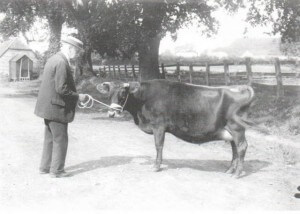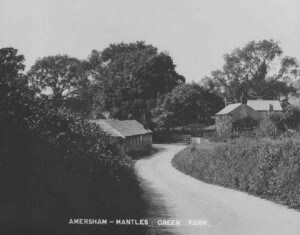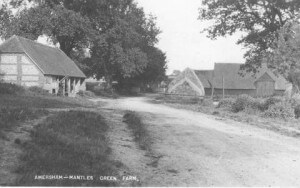Mr Matthews, choirmaster and farmer of Mantles Green Farm
Ernest Matthews lived in Elmodesham House from 1925 to 1930. His death notice is shown on that page.
Copied from the July 1981 Amersham Society News written by an ‘old resident’

My memories of Amersham go back over seventy years to the days well before the First World War. The Choirmaster in those days was Mr Matthews who had married the Squire’s sister and lived in Little Shardeloes. He had interests in slate quarries in South Wales, but his hobbies were dairy farming and music. He leased Mantles Green Farm from the Estate where he was a pioneer of the breeding of Jersey cattle in this country and he became President of the Royal Agricultural Society. On the musical side, he held quite high office in the Royal Academy of Music, serving on the Examining Board and being made a Doctor of Music and given the honour of L.L.D..
He was a great friend of the Reverend C E Briggs, the Rector of the time, and was for many years the voluntary organist and choirmaster at St Mary’s Church. I often think that we young boys never appreciated the musical training which we received from him. There was a practice for the boys, usually by candlelight, at his house on Monday evenings and for the full choir on Friday evenings in the Church.
I remember my first Sunday morning when I had been declared ready to sing in the Church on Sundays, a small boy who had to sit outside the choir stall, where, on either side, there were three rush-bottomed chairs with hard kneelers for those not able to sit in the stalls. The occupants had to kneel upright without support. The Rector said ‘The Litany’ and I felt the response ‘Have mercy upon us miserable sinners’ was very appropriate. The pattern of the kneeler remained on my bare knees to well after lunchtime.
Denis Carter was ‘Leading Choirboy’ and he sang a solo to the anthem ‘Jesu Word of God Incarnate’. He had a most lovely sweet treble voice and with the training given it was perfect. As just the new bottom boy on the ‘Cantoris’ side, I was almost spellbound. The leader on the ‘Decani’ side was Sonny Bailey. Others of that time were Ted Featherstone and Reg Fortnum (both killed in France), Fred and Ron Garton, Ron and Bert Toovey, Fred Darvil, George Line, Fred and Cecil Martin, Kenneth Welch, Steward Matthews, Leslie Betts – just some of the names which now come to me.
I well remember the Friday practices of the full choir in the Church and how we would all sing while Mr Matthews went to the west end of the Church. Suddenly he would stop us by calling up the Church and come hurrying to the Chancel and pin-point the slightest error and the culprit, who would then have to sing the piece alone until perfect before the practice could proceed. Sometimes he would say ‘Let us have the Gloria again’, each one individually, to find out who is singing ‘World without tend, Amen’ or again ‘It is not ‘O Lord may-kaste to help us’ or ‘It is not Halleeooyer, but Alley-lu-yar’ – finish with the mouth wide open and throw your voice out from the front of your mouth. Don’t sing back in your throats’.
The Monday practices were taken in his study at Shardeloes, either by himself or his daughter, Miss Diana. We were given lessons in voice production and exercise in singing separately or together as well as the singing of ‘Glees’ and reading music.
I particular remember one Glee:-
I sing because I love to sing,
Because instinctive fancies move,
Because it hurts no earthly thing,
Because it pleases some I love.
Alternate sides of the choir (Chorus):-
I sing, I sing, I sing, I sing
Both sides:- Because I love to sing. (Repeated, last time, slowly, with great feeling)
On festival days, Mr Matthews would come through our vestry from the Rector’s vestry to take his place at the organ and would say ‘Now my little men, don’t forget it is the long Amen today’ meaning the final response to the blessing at the end of the service.

Mr Matthews ran Mantles Green under the expert supervision and care of Tom Butler. Tom was a typical countryman, weather-beaten by continual outdoor life. He was so small in stature that when he was leading one of the big farm horses, the top of his hat was just about level with the bottom of the horse’s blinkers. If he was to be working on the fields all day, he would carry his lunch in a labourer’s wicker basket, slung over his shoulder. Mr Matthews said of him, ‘What Tom Butler doesn’t know about Mantles Green would not be worth knowing’.

Working with Tom, were three of his sons, the eldest, Jim, being in charge of the lovely farm horses. Fred was Cowman and had care of the famous Jersey herd and breeding and enlarging the herd. A prize bull was kept, the name of which escapes me, although it was on the wall of its stall together with its pedigree. Many of the milking cows were exhibited at the Royal Agricultural Show and won prizes. The third son was Billy who was ploughman and general farmhand. Other workers were Bill Tapping, Tom Harris, Jack Palmer, Cliff Ferris, Alf and Ted Shrimpton and George Castle who was the shepherd.

The number of men employed gives some idea of what mechanisation has done for agriculture. Additional work was carried out by older men, and women too, on a piece-work basis, picking stones from the fields at 1d or 2d per basket. These were of value for road making and repairing, being stacked by the roadside where old male pensioners would break them with hammers into smaller sizes to be rolled into the roads by steam roller. Additional help was also taken on for haymaking, harvesting and thrashing, and women came in to help with the milking.
Nowadays, walking along towards the farm, one notices very little difference. The door is still there where we, as children, took our cans and watched the milk being separated by the hand-turned separating machine and then had our cans filled for 1d per pint or 1.5d per quart. It was called skimmed milk but, being the lovely rich Jersey milk, it often had a layer of cream on when allowed to stand. Standing there, the figures and faces of the old farm workers come back and it is easy to imagine seeing them carrying out their duties as of old.

